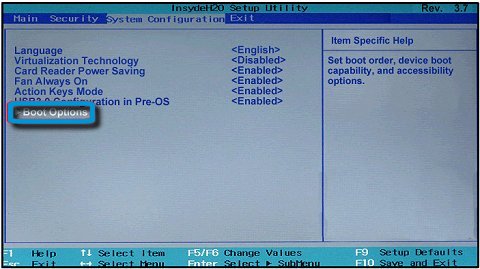
- INSYDEH20 SETUP UTILITY HP FACTORY RESET HOW TO
- INSYDEH20 SETUP UTILITY HP FACTORY RESET WINDOWS 7
- INSYDEH20 SETUP UTILITY HP FACTORY RESET WINDOWS
Power outages can cause serious problems on your hardware like PSU (Power Supply Unit) destruction or HDD (Hard disk) destruction (data loss). Close command prompt window and you ‘re done!Īttention: Always use a UPS (Uninterruptible power supply) to protect your computer hardware from voltage outages and voltage strikes.
INSYDEH20 SETUP UTILITY HP FACTORY RESET WINDOWS
bcdedit /set bootstatuspolicy ignoreshutdownfailuresĪfter pressing the “Enter” key, Windows should return an “ Operation completed successfully” message.ģ.In the command window, type the following command and press Enter. Right -click to “ Command prompt” item and choose “ Run as administrator”.Ģ.Open an elevated command prompt window by going to: To bypass this situation and to force Windows to start in normal mode after power outages or improperly shutdown, do the following:ġ. But in repair mode, you can not control your PC unless you sit in front of it.
INSYDEH20 SETUP UTILITY HP FACTORY RESET WINDOWS 7
In Windows 7 & Vista OS, after power failure Windows launches by default the “Startup Repair” settings instead of starting normally. Modify Windows to startup normally after power corruption, Set the “ Restore on AC/Power Loss” setting to “ Power On”. * Note: The “ Restore on AC/Power Loss” setting can be found under different places inside BIOS setup according to computer manufacturer.ģ. “ Advanced” or “ ACPI” or " Power Management Setup". Inside BIOS menu, look under the following menus to find for a setting named “ Restore on AC/Power Loss” or “ AC Power Recovery” or " After Power Loss". (The way to enter into BIOS Settings depends on the computer manufacturer).Ģ. Power On your computer and press " DEL" or " F1" or " F2" or " F10" to enter BIOS (CMOS) setup utility. Modify Power settings inside your BIOS.ġ.
INSYDEH20 SETUP UTILITY HP FACTORY RESET HOW TO
How to automatically start on (turning computer back / power on) after power outage. This guide can be very helpful for people that want to connect to their computer and work remotely (from a distance) when they are on a different location. In this tutorial I will show you how you can setup your computer in order to automatically power on after power outage. To boot your computer from the USB drive in basic BIOS, you can refer to this article. In Boot Option Priorities, change USB as the #1 boot option. Scroll through the list, disable Secure Boot and enable CSM. In the pop-up window, select Only Legacy OpROM. Press F2 to access the BIOS, choose the Boot option, and click Boot Device Control. In Boot Priority order, change USB HDD as the first boot order. In the Boot option, click Boot Mode, in the pop window, select Legacy BIOS. Press F2 to access the BIOS, in the Security option, disable Secure Boot. Most computer models including Acer, Toshiba, Samsung, Sony, Gateway and others use this. In the Startup option, select Both for UEFI/Legacy Boot and Yes for CSM Support. In the Security option, disable Secure Boot. 3.ThinkPad SetupĬlick F2 to access the BIOS.

Then you can see the Boot Order window, in Legacy Boot Source, choose USB Floppy. However, you can't set the boot order here. In Boot Option Priorities, change USB as the 1 boot option.

Select Security from the drop-down list, select Secure Boot Configuration, in the pop-up window, enable Legacy Boot, and disable Secure Boot. Press F2 to access the BIOS, choose the Boot option, and click Boot Device Control. Change the 1st Boot Device to USB Storage Device. Then disable Secure Boot Control, enable Load Legacy OPROM, and change Boot Mode to Legacy. To access the BIOS, press the Delete button. Before you continue, insert the USB Flash Drive on your computer. The settings for different motherboard and BIOS manufacturers are slightly different.


 0 kommentar(er)
0 kommentar(er)
